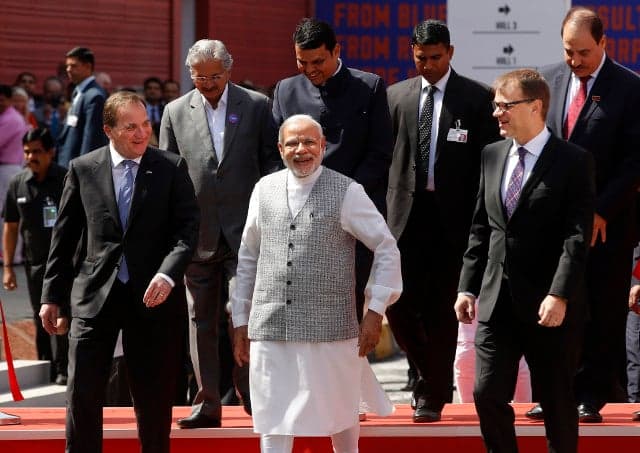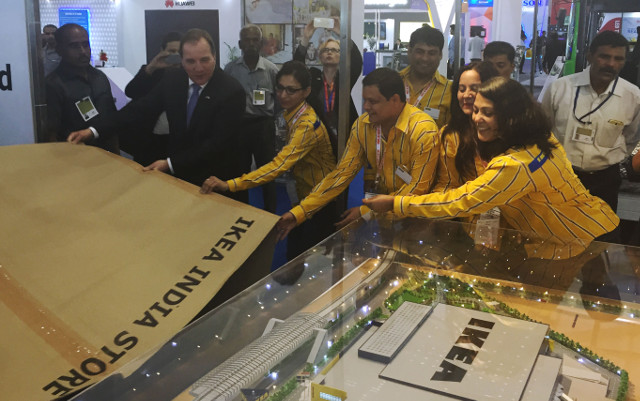From a Viking Buddha to Ikea: A brief history of Indian-Swedish relations

With Indian Prime Minister Narendra Modi visiting Sweden this month as part of an India-Nordic summit, The Local takes a look at Sweden's relationship with India, the roots of which may date back more than 1,000 years.
This article is available to Members of The Local. Read more Membership Exclusives here.
Viking contact?
Though neither of the two countries existed in their present-day forms at the time, people from the areas now known as India and Sweden may have been interacting since at least the year 700. In 1956 a bronze Buddha figurine dating from the 700s was found on Helgö island near Stockholm. One theory is that the Vikings brought the statue back from the Kashmir region along the Volga trade route via Russia. It's perhaps more likely though that the object passed through various different hands on its way to a Viking owner.

The Vikings travelled remarkably far, though India may have been too much of a stretch. Photo: Jacob Hamilton/AP
A flurry of diplomatic activity post-independence
Fast forward more than a thousand years and by the first half of the 1900s some of the biggest Swedish firms like Ericsson and Swedish Match were operating in India even before the country’s independence from Britain in 1947.
Sweden recognized the newly independent nation that year, India soon opened its embassy in Stockholm in 1948, and in turn Sweden opened its embassy in New Delhi in the 1950s. By the end of that decade the first state visit from an Indian Prime Minister to the Scandinavian nation occurred when Jawaharlal Nehru visited the Swedish capital in 1957.
There has been plenty more diplomatic exchange of the highest level since then: in 1993 Queen Silvia spent five days in India, while King Carl XVI Gustaf went there in 2005. In the last ten years alone two Swedish Prime Ministers (Stefan Löfven in 2016 and Fredrik Reinfeldt in 2009) have also made the trip, while in 2015 Pranab Mukherjee became the first Indian President to make a state visit to Sweden in a landmark occasion.
READ ALSO: India's President wraps up historic Sweden visit
Increased exchange in the 2000s
The recent relationship between the two countries has been driven by business in particular. More than 160 Swedish companies are now established in India, including powerhouses like Ikea and H&M, who are both expanding in the market. PM Löfven has been on a charm offensive when it comes to the ally as of late, supporting Modi’s key "Make-in-India" manufacturing summit and leading a delegation of Swedish industry leaders to the Mumbai launch event in 2016.
The rapport between the two leaders can be further seen in how Modi and India backed Sweden’s successful campaign to become a non-permanent member of the UN Security Council for the 2017-18 term, while Löfven has on several occasions expressed his support for India being given a permanent seat on a reformed council.
READ ALSO: No Swedish meatballs on the menu for Ikea in India
At present, India is Sweden's third biggest trade partner in Asia after China and Japan, and bilateral trade between the two nations hit the $2.2 billion mark in 2016. Exchange of labour is also a factor in the relationship these days: as of December 2017 there are just short of 30,000 people born in India living in Sweden, with industries like tech in particular attracting skilled labour, (though The Local has interviewed a fair share of Indian artists and creatives in the country). India is also a market of growing significance for Swedish firms looking to export new technologies.

Stefan Löfven revealing a model of Ikea's new warehouse in India. Photo: Tobias Österberg/TT
The sour note
Things haven't always been perfect between India and Sweden. Relations took a hit in 1987 with the Bofors scandal, which centered on a deal signed in 1986 when Swedish arms manufacturer AB Bofors got the contract to supply Howitzer guns to the Indian army.
READ ALSO: Swedish 'Deep Throat' comes clean over India leak
Indian and Swedish media later reported through the help of a whistleblower that the company had paid bribes to top Indian politicians and defence staff in order to make the deal happen. The scandal became so big it is thought it was a contributing factor to then Indian PM Rajiv Gandhi's failure to be reelected in the 1989 Indian general election.
That's about the sum of it as far as major incidents between the two nations go though, excluding this minor slip-up from Löfven's visit to India in 2016.
Comments
See Also
This article is available to Members of The Local. Read more Membership Exclusives here.
Viking contact?
Though neither of the two countries existed in their present-day forms at the time, people from the areas now known as India and Sweden may have been interacting since at least the year 700. In 1956 a bronze Buddha figurine dating from the 700s was found on Helgö island near Stockholm. One theory is that the Vikings brought the statue back from the Kashmir region along the Volga trade route via Russia. It's perhaps more likely though that the object passed through various different hands on its way to a Viking owner.

The Vikings travelled remarkably far, though India may have been too much of a stretch. Photo: Jacob Hamilton/AP
A flurry of diplomatic activity post-independence
Fast forward more than a thousand years and by the first half of the 1900s some of the biggest Swedish firms like Ericsson and Swedish Match were operating in India even before the country’s independence from Britain in 1947.
Sweden recognized the newly independent nation that year, India soon opened its embassy in Stockholm in 1948, and in turn Sweden opened its embassy in New Delhi in the 1950s. By the end of that decade the first state visit from an Indian Prime Minister to the Scandinavian nation occurred when Jawaharlal Nehru visited the Swedish capital in 1957.
There has been plenty more diplomatic exchange of the highest level since then: in 1993 Queen Silvia spent five days in India, while King Carl XVI Gustaf went there in 2005. In the last ten years alone two Swedish Prime Ministers (Stefan Löfven in 2016 and Fredrik Reinfeldt in 2009) have also made the trip, while in 2015 Pranab Mukherjee became the first Indian President to make a state visit to Sweden in a landmark occasion.
READ ALSO: India's President wraps up historic Sweden visit
Increased exchange in the 2000s
The recent relationship between the two countries has been driven by business in particular. More than 160 Swedish companies are now established in India, including powerhouses like Ikea and H&M, who are both expanding in the market. PM Löfven has been on a charm offensive when it comes to the ally as of late, supporting Modi’s key "Make-in-India" manufacturing summit and leading a delegation of Swedish industry leaders to the Mumbai launch event in 2016.
The rapport between the two leaders can be further seen in how Modi and India backed Sweden’s successful campaign to become a non-permanent member of the UN Security Council for the 2017-18 term, while Löfven has on several occasions expressed his support for India being given a permanent seat on a reformed council.
READ ALSO: No Swedish meatballs on the menu for Ikea in India
At present, India is Sweden's third biggest trade partner in Asia after China and Japan, and bilateral trade between the two nations hit the $2.2 billion mark in 2016. Exchange of labour is also a factor in the relationship these days: as of December 2017 there are just short of 30,000 people born in India living in Sweden, with industries like tech in particular attracting skilled labour, (though The Local has interviewed a fair share of Indian artists and creatives in the country). India is also a market of growing significance for Swedish firms looking to export new technologies.

Stefan Löfven revealing a model of Ikea's new warehouse in India. Photo: Tobias Österberg/TT
The sour note
Things haven't always been perfect between India and Sweden. Relations took a hit in 1987 with the Bofors scandal, which centered on a deal signed in 1986 when Swedish arms manufacturer AB Bofors got the contract to supply Howitzer guns to the Indian army.
READ ALSO: Swedish 'Deep Throat' comes clean over India leak
Indian and Swedish media later reported through the help of a whistleblower that the company had paid bribes to top Indian politicians and defence staff in order to make the deal happen. The scandal became so big it is thought it was a contributing factor to then Indian PM Rajiv Gandhi's failure to be reelected in the 1989 Indian general election.
That's about the sum of it as far as major incidents between the two nations go though, excluding this minor slip-up from Löfven's visit to India in 2016.
Join the conversation in our comments section below. Share your own views and experience and if you have a question or suggestion for our journalists then email us at [email protected].
Please keep comments civil, constructive and on topic – and make sure to read our terms of use before getting involved.
Please log in here to leave a comment.